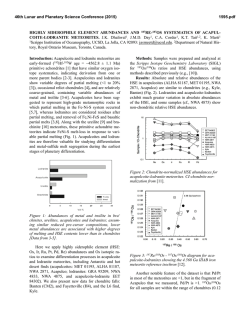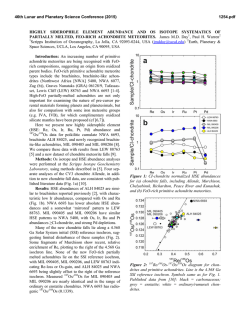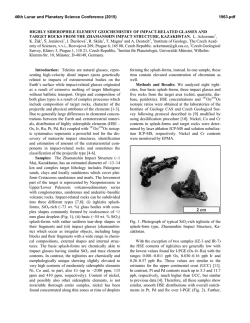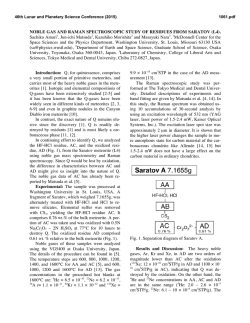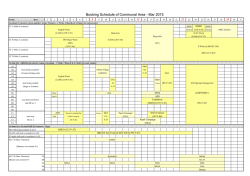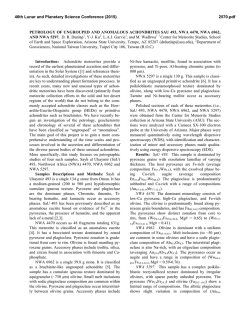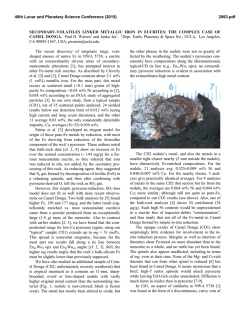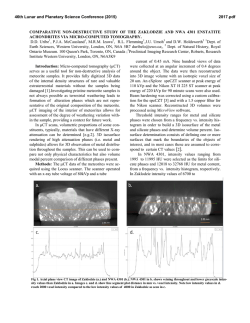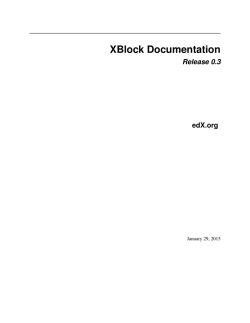
187
46th Lunar and Planetary Science Conference (2015) 1987.pdf HIGHLY SIDEROPHILE ELEMENT AND 187Re-187Os ISOTOPIC SYSTEMATICS OF UNGROUPED ACHONDRITE NORTHWEST AFRICA 7325 G. J. Archer1, R. J. Walker1, and A. J. Irving2 . 1Department of Geology, University of Maryland, College Park, MD 20742 ([email protected]). 2Department of Earth and Space Sciences, University of Washington, Seattle, WA 98195. Introduction: The processes involved with the transformation of chondritic, rocky aggregates into complex, differentiated bodies remain poorly constrained. Differentiated achondrites originate from parent bodies that have undergone a variety of processes, which may include metal segregation, crustmantle differentiation, and late accretion. Highly siderophile elements (HSE), including Re, Os, Ir, Ru, Pt, and Pd are useful for exploring the initiation of metal segregation because of their affinity for Fe-rich metal relative to silicate. They are also useful in constraining magmatic processes because of their diverse compatibilities during silicate partial melting [1]. Further, as they should be depleted from the silicate portions of planetary bodies that have undergone core formation, they are useful in constraining the addition of HSE-bearing material during late accretion [e.g., 2]. The Re-Os isotopic system (187Re →187Os + β-; λ=1.67 x 10-11a-1) is useful for constraining secondary processes that may have acted on achondrites [3]. NWA 7325 is an ungrouped, differentiated achondrite with a texture and bulk composition consistent with a cumulate olivine gabbro [4]. Prior studies have reported some compositional similarities between NWA 7325 and Hermian surface rocks [4]. Lead isotopes indicate that NWA 7325 has an age of 4562.5±4.4 Ma [5], which is consisitent with 26Al26 Mg isotopic systematics [6]. Here we present the first combined dataset of HSE abundances and Re-Os isotopic systematics for NWA 7325. Further, we provide models for the processes that may have established the HSE characteristics and Re-Os isotopic systematics of these samples. Methods: Two fragments of NWA 7325 were crushed into powders, then combined with isotopic spikes enriched in 190Os, 185Re, 99Ru, 194Pt, 191Ir, and 105 Pd. Samples, spikes, and ~5 mL 2:1 concentrated HNO3 + HCl were sealed within quartz digestion vessels and heated in a high pressure asher (HPA-S; Anton PaarTM) at 320 °C for 12 hours [7]. Osmium was then removed via solvent extraction using CCl4 and back extraction into HBr [8], and purified by microdistillation [9]. All other HSE were purified using anion exchange chromatography. Purified Os was analyzed by negative thermal ionization using a VG Sector 54 mass spectrometer. Rhenium, Ru, Pt, Ir, and Pd were analyzed using a Nu Plasma multi-collector-ICP-MS. Results: The HSE abundances of both fragments of NWA 7325 are much lower than those of CI chondrites, yet differ from one another by almost an order of magnitude (Fig. 1). NWA 7325 fragment A has chondritic relative HSE abundances, whereas fragment B is fractionated relative to bulk chondrites, with notably subchondritic Pt/Ir and suprachondritic Pd/Ir. Figure 1. CI normalized (x1000) [10] HSE abundances for fragments of NWA 7325. Uncertainties are smaller than symbols. NWA 7325 fragment A plots within uncertainty of a primordial 4568 Ma 187Re-187Os reference isochron. By contrast, NWA 7325 fragment B plots slightly above the primordial isochron (Fig. 2). Figure 2. 187Re/188Os vs. ΔOs for fragments of NWA 7325. ΔOs is the deviation in parts per 10,000 from a primordial reference isochron [11]. Discussion: The Re-Os isotopic systematics of NWA 7325 fragment A are consistent with system closure since formation, and there is no evidence for disturbance of HSE in this sample. By contrast, the minor deviations of NWA 7325 fragment B from a primordial isochron most likely indicate modest Re loss during terrestrial alteration, but suggest the other HSE were likely not substantially affected by the same process(es). 46th Lunar and Planetary Science Conference (2015) A model to account for the HSE abundances of NWA 7325 may require metal segregation, late accretion, and magmatic differentiation. The low HSE abundances of NWA 7325 are consistent with depletion by metal segregation during core formation. However, the HSE abundances are higher and less fractionated than those predicted by low-pressure metal-silicate partitioning experiments [e.g., 12] for a silicate fraction following metal-silicate partitioning. The difference in absolute HSE abundances between the two fractions indicates that HSE carriers are heterogeneously distributed in the bulk rock, and that material was likely added shorty before or after crystallization. It is possible that the melt from which this rock crystallized inefficiently assimilated regolith containing chondritic HSE. However, given the small size of the total meteorite (~1.5 kg), it is difficult to envision an assimilation process that only partially affected the rock. Instead, the most likely cause of the HSE variation is addition of exogenous chondritic material following crystallization, possibly during late-stage impacts on the parent body. The higher (Ir = 0.9 ng g-1) and chondritic-relative HSE abundances of fragment A indicate that a significant fraction (~0.2%) of chondritic material must have been added to this fragment, whereas chondritic contamination was negligible for fragment B. Thus, fragment B may provide more valuable information about interior parent body processes. Prior studies have reported that some diogenites [2] and angrites [13] have fractionated HSE patterns and absolute abundances similar to fragment B. These studies argued that the HSE fractionations of those samples were caused by crust-mantle partitioning, and the HSE fractionations of NWA 7325 fragment B could have also been caused by crust-mantle partititoning. However, the subchondritic Pt/Ir of this sample is inconsistent with Pt and Ir behavior during crustmantle partitioning in any known system. Modeling of metal-silicate partitioning, using distribution coefficients for 5-60 GPa [14] cannot reproduce the HSE characteristics of fragment B, but a multi-stage model using low-pressure (1 atm) HSE partition coefficients [15,16,17,18,19,20,21] can. For this model, an originally chondritic parent body is envisioned to undergo multiple episodes of low-pressure metal-silicate equilibration, a single stage of late accretion, and near surface addition of chondritic material. In the first stage (Fig. 3), an originally chondritic (CI chondrite HSE; [22]) parent body differentiates into a 70% silicate fraction and a 30% Fe-Ni metal fraction. In stage 2, a small fraction (10-9 wt.% CI) of chondritic material is mixed into the silicate fraction during late accretion. In the third stage, a second metal-silicate equilibration event occurs between the silicate fraction 1987.pdf and a small fraction of Fe-rich metal grains (10-6 %), followed by metal segregation. Calculated HSE abundances of a rock crystallizing from 99% silicate and 1% of the metal, resulting from stage 3 are shown in Figure 3. Finally, a small fraction (0.01 wt.%) of CI chondritic material is added to the crystallized rock, and the final HSE characteristics are broadly similar to those of fragment B. Figure 3. Model HSE abundances at different stages (Sx refers to individual stages described in the text). Data for CI chondrites from [22]. References: [1] Barnes S.-J. et al. (1985) Chem. Geol. 53, 302-323 [2] Day J.M.D. et al. (2012) Nat. Geosci. 5, 614–617 [3] Becker H. et al. (2001) Geochim. Cosmochim. Acta 65, 3379–3390 [4] Irving A.J. et al. (2013) LPSC 44, #2164 [5] Amelin Y. (2013) MAPS, #5165 [6] Dunlap D. R. et al. (2014) LPSC XLV, 2186 [7] Meisel T. (2003) J. Anal. Atomic Spectr. 18, 720–726. [8] Cohen A.S. and Waters F.G. (1996) Anal. Chim. Acta 332, 269–275 [9] Birck J.L. et al. (1997) Geostand. Newsl. 21, 19–27 [10] Horan M.F. et al. (2003) Chem. Geol. 196, 5-20 [11] Becker H. et al. (2001) Geochim. Cosmochim. Acta 65, 3379–3390 [12] Capobianco et al. (1993) J. Geophys. Res. – Planets 98, 5433–5443 [13] Riches et al. (2012) Earth Planet. Sci. Lett. 353-354, 208-218 [14] Mann U. et al. (2012) Geochim. Cosmochim. Acta 84 593–613 [15] Walter et al. (2000) In Origin of the earth and moon, 265-289 [16] Ertel et al. (2001) Geochim. Cosmochim. Acta 63 2439-2449 [17] Borisov A. and Palme H. (1998) N. Jb. Miner. Abh. 172, 347-356 [18] Borisov A. and Palme H. (1995) Geochim. Cosmochim. Acta 59, 481-485 [19] Borisov A. and Nachtweyh K. (1998) LPSC XXIX, 1320 [20] Ertel W. et al. (1999) Geochim. Cosmochim. Acta 63, 2439-2449 [21] Borisov A. and Palme H. (1994) Geochim. Cosmochim. Acta 58, 705– 716. [22] Fischer-Gödde M. et al. (2010) Geochim. Cosmochim. Acta 74, 356-379.
© Copyright 2025
